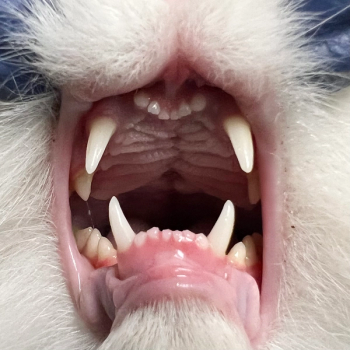
Pelvic fractures and soft tissue trauma (Proceedings)
Fractures of the pelvis are common.
Fractures of the pelvis are common. The majority of pelvic fractures are multiple because of the boxlike configuration of the pelvis. For displacement of pelvic fractures to occur, the pelvis must be disrupted, either fractured or luxated, in at least 2 places. Surgical repair of pelvic fractures is required for the weight-bearing portions of the pelvis. These are the acetabulum, ilium, and sacroiliac joint. Conservative treatment is appropriate for pubic and ischial fractures. Pelvic fractures should be repaired within 5 to 7 days after the injury. Beyond one week, manipulating pelvic fracture fragments into place is almost impossible and surgery should not be attempted. The only surgery recommended for chronic pelvic fractures is a femoral head and neck ostectomy (FHO) for acetabular fractures.
The risk of conservative treatment for weight transferring surfaces of the pelvis, particularly ilial fractures, is narrowing of the pelvic canal. This can cause difficulty defecating (obstipation), especially in cats, or dystocia in breeding females.
Pelvic fractures most commonly occur after major trauma. The potential for significant soft tissue injury is high so a thorough physical examination is essential. Soft tissue trauma can involve the thoracic and abdominal cavities and the peripheral nerves.
Physical Exam for Pelvic Fractures
1. Extensive palpation and manipulation of the pelvis is unnecessary because radiographs will be taken.
2. Check for pelvic asymmetry by comparative palpation of the iliac crests, greater trochanters, and ischial tuberosities.
i. Cranial displacement of the iliac crest indicates sacroiliac luxation.
ii. Cranial displacement of the greater trochanter indicates ilial fracture.
iii. Cranial dorsal displacement of the greater trochanter indicates coxofemoral luxation.
iv. Gentle rotation of the hip joint that elicits pain or crepitation is consistent with acetabular or proximal femoral fractures.
Specific Fractures
Ilial fractures
Most ilial fractures are oblique due to the slope of the ilium in relationship to the sacrum. In most cases the caudal ilial section is displaced medially and cranially. Sciatic nerve injury can occur by medial displacement of the ilium.
1. Anatomy: The lateral side of the ilial wing is concave in shape. This concave shape must be maintained when fractures are repaired to avoid reducing pelvic canal diameter. The sciatic nerve courses along the medial side of the ilium as it exits from the underside of the sacrum to the ischium.
2. Surgical stabilization:
i. Ilial fractures are usually repaired with dynamic compression (DCP) plates. Reduction of fracture fragments can be challenging because the caudal fracture fragment is wedged underneath the cranial fragment. The caudal fracture fragment can be lateralized by levering it up with a periosteal elevator. Kern bone holding forceps can then be used to grasp the caudal fragment. If needed, further traction can be applied to the caudal fragment by performing a small surgical approach to the caudal ischium in order to take hold of it with Kern forceps. Manipulation of the ischium will also manipulate the ilium as long as there is not a fracture of the ischium. Once the fracture fragments are in place, reduction can be maintained with pointed bone reduction forceps while the bone plate is being applied.
ii. The bone plate must be contoured to match the normal concave shape of the ilium. This is done with a plate bender.
iii. It is not always possible to place 3 screws in each fracture fragment. The caudal fracture fragment often is too small for anything more than 2 screws. Despite this, ilial fractures usually heal well with a bone plate that has 2 caudal screws and 3 cranial screws.
Acetabular Fractures
Acetabular fractures are some of the most technically demanding fractures to repair. Acetabular fractures are classified as being cranial, central, caudal or comminuted. Occasionally, the medial wall of the acetabulum separates from the other acetabular segments. Even with repair of the dorsal articular surface of the acetabulum, the femoral head is prone to protrusion through the resulting hole in the medial wall and into the pelvic canal. For this type of fracture and for comminuted acetabular fractures, a femoral head and neck ostectomy (FHO) is a good option.
Historically, some surgeons suggested that fractures of the caudal third of the acetabulum did not require repair because most weight bearing is borne by the cranial 2/3 of the acetabulum. A review of nonsurgical treatment of 15 dogs with caudal-third acetabular fractures showed that nonsurgical treatment yielded poor results. Dogs developed moderate to severe degenerative joint disease, decreased range of motion, pain and lameness.
1. Anatomy: The central part of the acetabulum is the point of attachment of the ligament of the femoral head and is called the acetabular fossa. The ligament typically remains attached to this portion of the acetabulum after fracture has occurred. The sciatic nerve runs over the caudal dorsal portion of the acetabulum and must be treated carefully during surgery.
2. Surgical Stabilization
i. Acetabular fractures are usually stabilized with acetabular plates. Acetabular plates are curved in design to fit the dorsal acetabular rim. Reconstruction plates can also be used for acetabular fractures. Reconstruction plates are made of softer steel and are "V" notched between screw holes so they may be contoured in dorsal-ventral as well as medial-lateral directions. Reconstruction plates are particularly useful for combined ilial and acetabular fractures because they come in a variety of lengths and can be contoured to follow the pelvis. Although reconstruction plates are less stiff than standard plates, they are adequate for this purpose. The biomechanical properties of a 3.5 mm five-hole reconstruction plate were found to be the same as a 2.7 mm five-hole acetabular plate when applied to acetabular osteotomies.
Acetabular or reconstruction plates are well-suited to repairing cranial or central acetabular fractures. Caudal acetabular fractures often do not have enough bone in the caudal piece to place a bone plate. Another technique called composite fixation can be useful for caudal acetabular fractures.
ii. Composite fixation: With this technique, fracture fragments are put in proper position and then secured with K-wires. Next a screw and washer is placed in each fragment and then a wire is anchored to each screw and tightened. The pull of the wire should be perpendicular to the fracture line. A small dollop of bone cement is then placed on top of the screws and wires to solidify the repair. The biomechanical properties of the composite fixation technique are similar to properties of acetabular bone plate fixation.
Sacroiliac Luxations
Sacroiliac luxation (SI luxation) is traumatic separation of the wing of the ilium from the sacrum without fracture into either the ilium or the sacrum. Occasionally a piece of the sacral wing fractures off and remains attached to the ilium. This would be referred to as a sacral fracture/luxation but is repaired the same way as a sacroiliac luxation. Occasionally SI luxations do not require surgery if the other side of the pelvis is stable and if the cranial displacement of the ilium is very mild. Repair of sacroiliac luxations usually leads to early weight bearing.
1. Anatomy: Most of the sacrum is the sacral wing. The sacral body is the part of the sacrum capable of securely holding screws. In an average-sized dog the sacral body is only approximately 1 cm2 . The greatest challenge with repairing a sacroiliac luxation is locating the sacral body. There are some landmarks: 1. the sacral body is located approximately 60 % of the way from the dorsal to ventral sacral wing. 2. Most animals have a small cranial notch in the sacral wing. The sacral body is directly behind this cranial notch.
2. Surgical Stabilization: SI luxations are stabilized using a lag screw. The screw should penetrate 60 % of the width of the sacral body for adequate stability. A review of the literature indicates that a single screw, if it crosses at least 60%, is stable. Two screws did not prevent fixation loosening better than one.
Coxofemoral Luxation
Cranial dorsal is the most common direction for coxofemoral luxation.
1. Anatomy: There are 3 major stabilizers of the coxofemoral joint: the ligament of the femoral head, the joint capsule, and the dorsal acetabular rim. Hip luxation is associated with rupture of the joint capsule and the ligament of the femoral head. The dorsal acetabular rim is not usually damaged.
2. Initial treatment: Closed hip reduction
a. Description: The initial treatment for hip luxation is closed reduction. To do this the patient is placed under anesthesia or given an opiate and sedative along with an epidural block. The animal is positioned in lateral recumbency with the affected limb uppermost. With one hand, the limb is grasped at the hock, externally rotated and pulled distally. The greater trochanter is moved caudally and distally towards the acetabulum. Moderate pressure is applied to the greater trochanter and the hip is put through a range of motion.
b. The limb is placed in an Ehmer sling and radiographs are taken (lateral view) to confirm reduction of the hip joint. An Ehmer sling places the hip joint in flexion and internal rotation and helps oppose craniodorsal hip luxation. The Ehmer is kept on for 5 to 7 days and checked every 2 to 3 days. Cats do not tolerate an Ehmer well (don't recommend it in cats).
c. Success of closed hip reduction: Successful in 35 to 53 % of affected dogs (approximately 50:50 chance) and 62% of cats.
3. Surgical Treatment: All techniques involve an approach to the hip joint. The remnants of the round ligament are excised from the acetabulum because they occupy space and can induce re-luxation if not removed.
a. Prosthetic imbrication technique: Perform a trochanteric osteotomy approach to the hip. Place suture anchors in a dorsal and slightly cranial position in the dorsal acetabular rim. Drill a hole in the femoral neck. Run suture from the anchor, through the hole, and tie suture with the limb held in a position that is parallel to the floor. Replace greater trochanter with tension band fixation.
b. Toggle pin fixation: A toggle pin technique recreates the round ligament. A drill hole is made through the neck of the femur and into the center of the acetabulum (where the round ligament originates). The toggle pin (sometimes called a toggle rod) is a metal implant that holds suture. The toggle pin and suture are passed through the drill hole in the femoral neck and medial acetabular wall. When the toggle pin is deep to the acetabulum, it is pulled and changes orientation so that it won't pull back through the hole in the acetabulum.
c. Capsulorrhaphy: The hip joint is surgically approached. The acetabulum is inspected and ligament remnants are removed. The hip is replaced in the joint and the joint capsule is closed.
1. Results: reluxation rate of 0 to 6%. The majority of patients return to normal gait. Approximately 20% of patients will have some residual lameness. The relaxation rate after joint capsulorrhaphy alone is reported to be higher (10 -17%).
4. Treatment for patients with pre-existent hip arthritis
a. Femoral head and neck ostectomy
b. Total hip replacement
Soft Tissue Injuries Associated with Pelvic Fractures
Urinary Tract Trauma
1. Urinary tract trauma can cause leakage of urine into the abdomen or into the perineal tissues. Either case would cause azotemia. Other clinical signs would include abdominal distension or, with perineal leakage, inguinal or perineal bruising that gets progressively worse.
2. Retrospective study. Selcer BA: Urinary tract trauma associated with pelvic trauma. JAAHA 1982.
a. Results: 39 % of dogs had urinary tract injury. 16% of dogs required surgical correction of the urinary tract injury
4 ureteral avulsions, 7 bladder tears, 5 urethral tears
b. Only the male dogs had urethral tears.
1. Long narrower urethra makes males more susceptible to rupture.
2. Pubic fractures were the most frequent pelvic fracture associated with urinary tract trauma.
Neurologic damage to lumbosacral nerve segments or roots.
1. Pelvic, pudendal, hypogastric nerves (sacral nerve roots)
a. Damage to these nerves by compressive force can cause a lower motor neuron bladder. Damage may be a temporary contusion to the nerves that will require management with a urinary catheter. Failure to recognize this condition can lead to overdistension of the bladder with the potential for irreversible fibrotic change in the detrusor muscle.
b. Sacral fractures:
Sacral fractures are classified as axial or abaxial. Axial sacral fractures are closer to midline and are more highly associated with neurologic impairment.
1. The sacrum contains nerve roots (S1 to S3) that contribute to the pelvic, pudendal, and perineal nerves, as well as the S1 component of the sciatic nerve. The caudal nerves supplying the tail are the distal continuation of the cauda equina.
2. Sacral fractures may result in urinary or fecal incontinence and neurologic of the perineum and tail.
3. In a review of 32 dogs with sacral fractures, approximately two-thirds (69 %) had neurologic deficits at presentation. (Kuntz, JAAHA 1995)
a. 41 % had complete or partial denervation of the tail.
b. Animals with flaccid tails had decreased bladder function and some also had fecal incontinence.
c. Many patients with severe neurologic deficits recovered completely, with the greatest proportion of neurologic recovery occurring after discharge (usually within 30 days after the trauma).
2. Sciatic nerve
The sciatic nerve is formed from spinal cord segments L6, L7 and S1, and these segments are located at vertebral bodies L4 and L5. The sciatic nerve courses medial to the ilium and dorsomedial to the acetabulum. Sciatic nerve injury was recorded in 2 of 45 dogs with pelvic fractures (Phillips, J Small Anim Pract,1979). Sciatic nerve damage can occur with any pelvic fracture case, but greatest risk is with ilial fractures.
a. Physical exam: To evaluate the integrity of the sciatic nerve, assess for conscious pain sensation of the middle and lateral digits. Also evaluate the flexor withdrawal.
b. Decreased or absent sensation or motor of a peripheral nerve may be temporary (neuropraxia) in which case function should return by 3 to 6 weeks.
Abdominal Hernia
1. Clinical signs: swollen and bruised caudal abdomen or inguinal region. Occasionally bowel loops may be palpated.
2. Types of traumatic abdominal hernias
a. Prepubic tendon rupture/avulsion: Insertion of rectus abdominus muscle on pubic bone is damaged.
b. Inguinal hernia: damage to inguinal ligament.
c. Femoral hernia: Abdominal musculature and peritoneum detached from proximal medial thigh.
Perforated Intestine
Clinical signs: Evidence of this injury may be covert at first. The administration of antibiotics or nonsteroidal anti-inflammatory drugs for treatment of traumatic injuries may mask the fever that would be expected with peritonitis.
3. Diagnosis of bowel rupture:
a. Increase white blood cell count (quite high >30,000 cells)
b. Evidence of abdominal fluid.
c. Diagnostic peritoneal lavage (DPL): Increased white blood cells and presence of bacteria.
Newsletter
From exam room tips to practice management insights, get trusted veterinary news delivered straight to your inbox—subscribe to dvm360.






